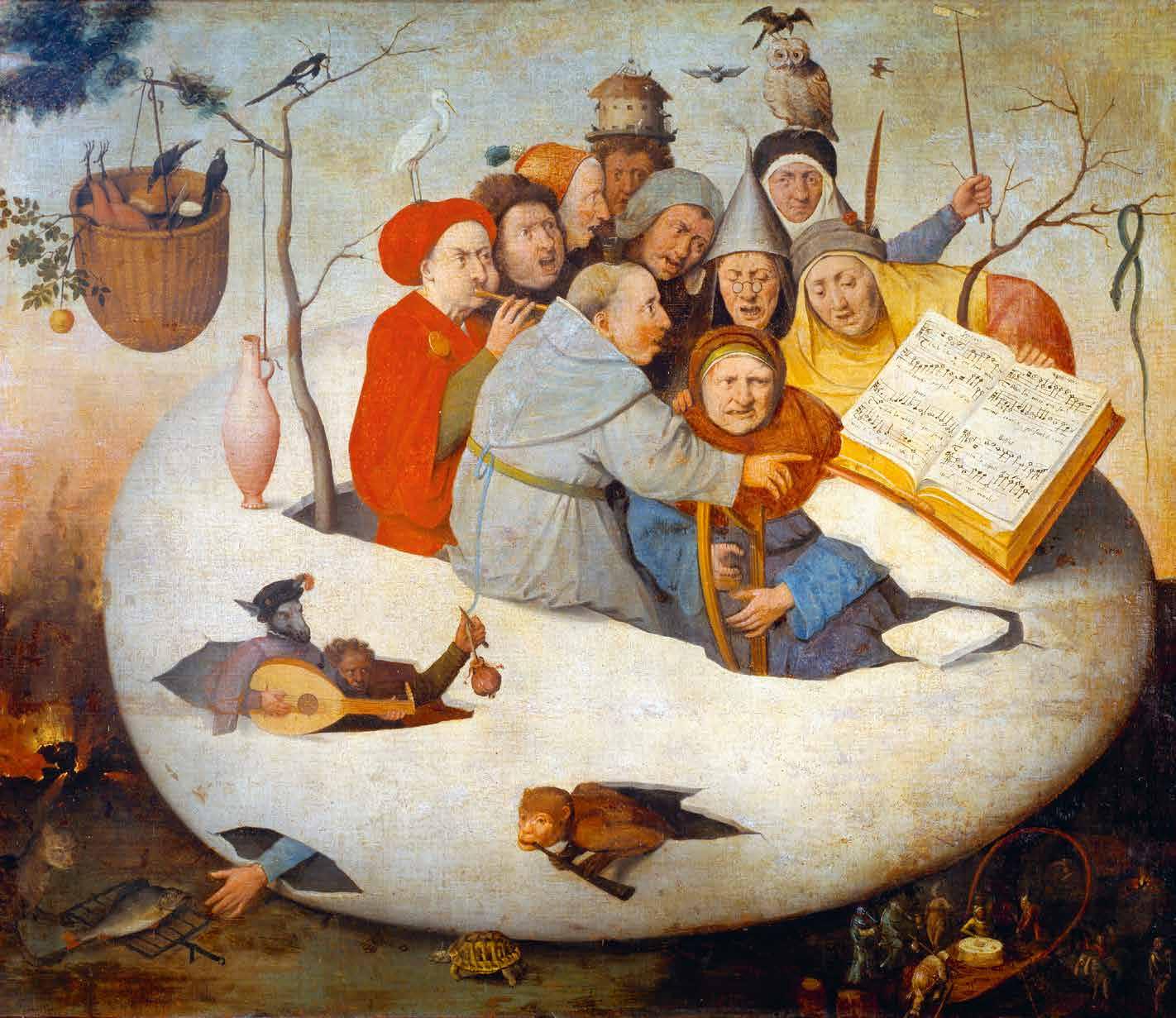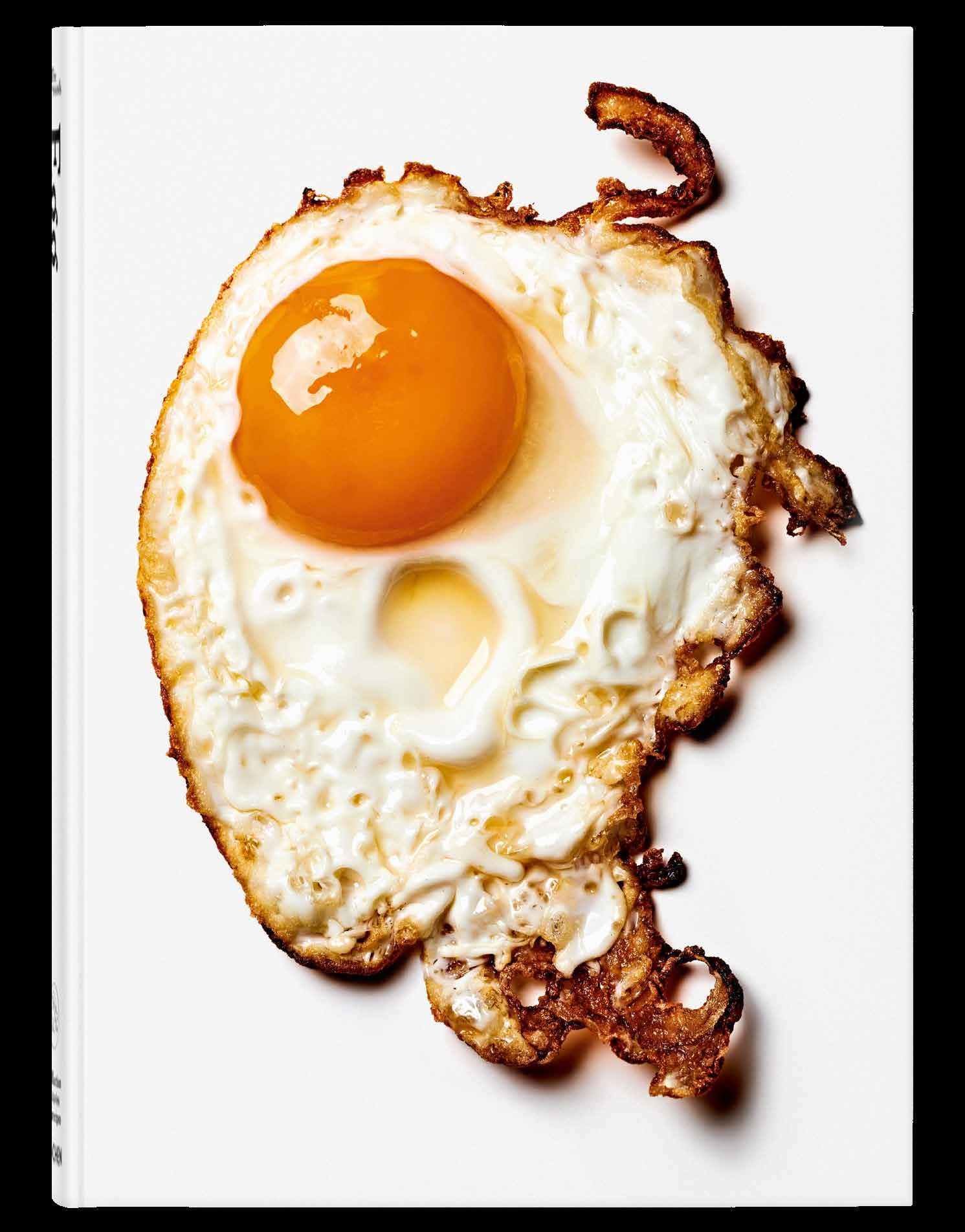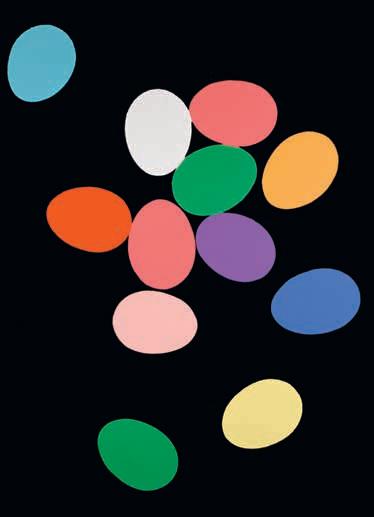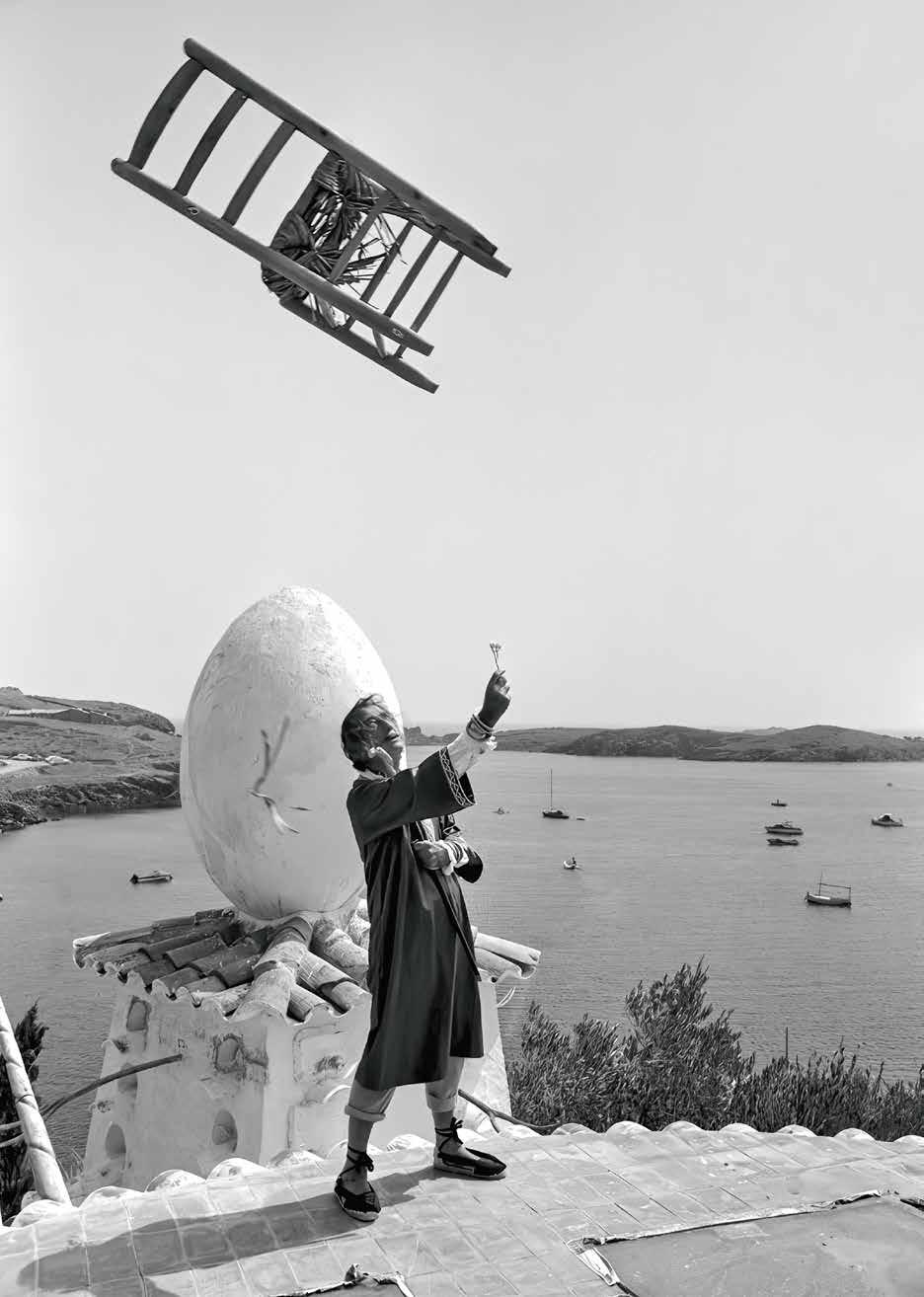The Mighty Egg Excerpt from Eggs Are Everywhere
By Jennifer Higgie
An egg is a deceptively simple object. It is a symbol and a shape-shifter, a food and a metaphor, an industry and an inspiration, a millennia-old, cross-cultural expression of rebirth, fertility and potential. It’s also a star of literature, music, design and film.
From the Golden Egg of Aesop’s Fables to West Egg and East Egg, the two main locations in The Great Gatsby; to Alice hunting Easter eggs in Through the Looking Glass, and the gleeful absurdity of Dr Seuss’s beloved children’s book Green Eggs and Ham; to song lyrics, from The Beatles “I am the Eggman” and Ella Fitzgerald and Louis Armstrong duetting “I’m Putting All My Eggs in One Basket.”
The egg is also at the crux of the oldest question around, “What came first, the chicken or the egg?”, and an insult, “You’ve got egg on your face.” And that’s hardly touching upon it.
The creation story of the cosmic egg, the idea that the world was hatched by a greater power, is a recurring theme in many societies; it was first written down around 1500 bce in Sanskrit scriptures, and in origin myths from Australia to China to Greece. In the Persian Empire, the spring equinox was celebrated by the decoration, sharing and eating of eggs. A carved relief from the ruins of the capital Persepolis (c.500 bce) depicts noblemen holding colored eggs. Later, Christian cultures adopted many of the pagan spring rituals as symbols of Christ’s resurrection at Easter. Now, eggs at Easter are ubiquitous, from the elaborately decorated Ukrainian pysanky—eggs painted using beeswax and dyes—through to the l’uovo di Pasqua in Italy: large hollow chocolate eggs wrapped in colorful foil with a gift inside. Of course, there’s also the endless mass-market chocolate versions, the most notable of which has to be Cadbury’s Creme Egg, which celebrated its 50th anniversary in 2021.
In Egyptian mythology, the bird goddess Isis, the daughter of Geb, the earth god, who was represented by a goose, was known as the “Egg of the Goose”. In Thebes, rendered on the walls of the tomb of Horemheb, the last pharaoh of the 18th Dynasty (1306–1292 bce) is a painting of a man carrying a bowl of eggs, while a small sculpture of an egg-filled nest was found in Tutankhamun’s tomb—an indicator, perhaps, of life after death.
In 2010, a cache of 60,000-year-old crushed ostrich eggs was found in South Africa. There was evidence that they had once been engraved and possibly painted, although what the marks signified is still unknown. There are so many tales of eggs in history that it’s dizzying. What is clear is that, for centuries and across continents, their significance extends far beyond food.
One of the earliest representations of an egg is a Roman fresco of a still life with eggs and thrushes, painted by an unknown artist on the walls of the Villa di Giulia Felice in Pompeii, which is still visible there today. But it was during the Renaissance that the creative possibilities of the egg really took hold. It appears again and again in various guises; in still lifes and allegories, as well as religious, historical and domestic scenes.
One of its most beautiful incarnations is in Piero della Francesca’s Brera Madonna (1472–1474). A single ostrich egg, here intended as a symbol of creation and purity, is suspended from a shell above a group of saints and angels who surround Mary, the sleeping Christ Child stretched across her lap. The fact that the ostrich was a heraldic sign of the Montefeltro family who commissioned the tempera panel was undoubtedly a handy compositional prompt.
Many artists, of course, have decided to focus not on the egg’s metaphorical possibilities, but instead on its day-to-dayness. In the German painter Georg Flegel’s Snack with Fried Eggs (c.1600), an egg is an egg and no less glorious for it. The artist is displaying his
Still Life with Eggs, Birds and Bronze Dishes from the House of Julia Felix Pompeii, 50–79 bce. © 2022. Photo Scala, Florence, courtesy of the Ministero dei Beni e Att. Culturali e del Turismo.
talents: he can paint a reflective glass, a red flower, a loaf of bread and a couple of oily fried eggs with such vivid realism that it encourages hunger pangs.
Similarly, Diego Velázquez’s An Old Woman Cooking Eggs (1618) is also something of a celebration of the everyday. Painted when he was still a teenager, even at a distance of 400 or so years, the picture is as vivid as a film still. The cook holds an egg in her left hand; in her right is a wooden spoon that hovers above the two eggs frying in a terracotta pot. A young boy waits beside her with a flask of wine and a pumpkin. Velázquez’s prodigious talents are highlighted in the textures he evokes with the most economical of means: the white plate, the silver knife, and the gleam of the frying eggs that you can almost hear spit and hiss.
Realism was not held in much esteem by some painters, however. One of the strangest works of the 16th century is a Flemish painting, Concert in the Egg (c.1561), painted after a lost picture by Hieronymus Bosch. Like a premonition of the egg-obsessed surrealism of Salvador Dalí, in the demented scene ten musicians (including a nun with an owl on her head) are crammed into an eggshell—perhaps a play on the familiar subject of a ship of fools. They perform a work by the composer Thomas Crecquillon that is inscribed in a large book; they sing, play a harp and a flute. Distracted by the music, a monk is pick-pocketed by a mystery hand while various animals, including a monkey, a cat and a turtle, lurk in the margins. Other worlds are intimated by a tiny crowd scene in the bottom right of the picture. The composition resembles other works by Hieronymus Bosch, for whom the egg offered endless creative potential. In perhaps Bosch’s
most famous painting, the triptych The Garden of Earthly Delights (c. 1490–1510)—which moves from depictions of Eden to sensual abandonment and then Hell—an unhatched egg floats in the dead centre of the middle panel, surely a symbol of unrealised hope, or potential, in the midst of human folly.
As in so many pictures, the egg often features not only as an everyday foodstuff but as a container of myriad meanings. To paint an egg is to fuse simplicity of form and shape with the resonances around mortality that lurk at the heart of still life.
Giovanni Battista Recco’s Still Life with Chickens and Eggs (1640–1660) is case in point. It combines 11 eggs, one of which is broken, two live chickens and two dead ones. A knife hovers on the edge of the table, a nod to the precariousness of life.
In the 19th century, even as artists were pushing against tradition, the egg as a popular subject persisted. In Paul Cézanne’s muscular Still Life with Bread and Eggs (1865), the motif of the single knife returns, linking a crisp white cloth with a crusty baguette, a glass and two eggs. That it emerges from darkness lends this everyday scene an otherworldly atmosphere. Just over 40 years later, Claude Monet banished any intimation of gloom with his Still Life with Eggs (1907), a pinkish, light-filled composition that blurs at the edges; it’s like squinting into the sun on a summer’s day. And it surely inspired the English artist Cedric Morris’s joyful still life The Eggs (1944), which was painted during the dark days of World War II: its bright palette of blues, lilacs and yellows, and the 12 colorful eggs arranged in a basket, are a sign of hope for new beginnings. The great postwar cook and food writer Elizabeth David bought the painting in 1953,

Concert in the Egg, c. 1561. © DeAgostini Picture Library/Scala, Florence.
and in 1984 it was chosen as the cover image for the first edition of her classic book An Omelette and a Glass of Wine.
Despite its self-containment, the egg is the most pliable of subjects. In the 20th century, it was many things to many artists and designers. Constantin Brancusi mined the border between abstraction and figuration in his marble, nickel, silver an stone sculpture The Beginning of the World (c.1920), a simple ovoid form that he repeatedly returned to that was suggestive of fertility and infinity—a motif that Frida Kahlo also summoned in her feverish meditations on birth, life and death. In Man Ray’s Egg and Shell, Solarization of 1931, two hands bring an egg and seashell together in a gesture that is both unremarkable and moving in its linking together of something very old and very new.
In her 1963 work The Moment (Egg) the artist Agnes Martin—who believed that “art is the concrete representation of our most subtle feelings”—employed the shape of the egg as the expression of limitlessness, and in 1969 David Hockney illustrated a story by the Brothers Grimm with a series of 39 etchings, including the enigmatic The Boy Hidden in an Egg.
For Salvador Dalí, the egg was a malleable metaphor for the strangeness of everyday life, an intimation of the erotic, and the rebirth of vision that surrealism promised. In the one-minute film Salvador Dalí & Gala Born from an Egg, two large eggs sit side by side on a sunny beach. As the artist and his wife burst out of one, he exclaims “Bonjour!” and then proclaims that he is born “without any kind of traumatism”. He scatters “symbolic blood, milk and fish” around the base of the egg, “the blood of Gala and the blood of the Divine Dalí”. In homage to the significance of the egg to the artist, large sculptures of eggs decorate the roof of the Dalí Theatre and Museum in Figueres in Spain, and a single giant egg sits atop the artist’s Casa-Museu (HouseMuseum) in Port Lligat in Cadaqués.
It’s unsurprising that the egg is such a popular motif in Pop Art, which reframed the everyday as something heightened and hallucinatory. Straddling painting and sculpture, one of the movement’s stars, Claes Oldenburg, was fascinated with both the simplicity and the comic potential of eggs, and they appeared in many of his works.
One of the most prolific late-20th-century explorers of the egg was the German artist Martin Kippenberger. His final exhibition in 1997, the year he died, was Der Eiermann und seine Ausleger (The Eggman and His Outriggers) at the Städtisches Museum Abteiberg in Mönchengladbach, Germany. Comprising paintings, drawings and objects organised around the theme of the egg, the artist restlessly explored “rebirth, reproduction and the ideal of the circle”, both as a serious cipher and as a “banal comedic device”. More recently, the Swiss artist Urs Fischer took the joke and ran with it in his series of Problem Paintings (2013): giant photographic portraits in which the subject’s face is obscured by photorealist painted eggs. The US artist Jeff Koons has also taken things to a whole new level in his dizzying, gleaming sculptures of blindingly shiny eggs cracked or wrapped in bows.
The echo of a breast in the shape of an egg yolk has long been remarked upon, and some of these works, including Vicki Hodgetts’s Eggs to Breasts, are explored in this book. From the 1970s until her death in 2017, the Italian feminist artist, poet and curator Mirella Bentivoglio employed the egg as a stand-in for the letter “o”: if her body was an “I”, together they would make “io”—Italian for “I”. In the 1990s, the French-American artist Louise Bourgeois created monumental sculptures of spiders—which she saw as a maternal figure—guarding their eggs, like the guarantee of something to come. The British artist Sarah Lucas, who has returned to the motif of the egg again and
“Chicken portraits, egg decor, famous egg artworks, plus recipes highlighting and essays examining our favorite single-celled food? Yes, please…”
Andy Warhol Eggs, 1982.
© 2023 The Andy Warhol Foundation for the Visual Arts, Inc. / Licensed by Artists Rights Society (ARS), New York.
“Editorially experimental, visually conceptual, but highly accessible because of the sheer wit of its inventive features, The Gourmand offers surprising delicacies.”
again, created the participatory One Thousand Eggs: For Women for her 2018 solo exhibition at the New Museum in New York. A take on both the history of egg tempera and the pagan fertility rite of egg throwing, it involved women smashing 1,000 eggs against the gallery wall to make the work.
In the past few years, the popularity of the egg is as strong as ever. From Wolfgang Tillmans’s and Stephen Shore’s contemplative photographic still lifes to Christopher Chiappa’s hyperrealist sculptural work of 7,000 fried eggs installed on the walls and the floor of a gallery, and Heather Phillipson’s wonderfully bonkers commission for a London Underground station in 2018, the egg has become something of a one-stop shop for inference and ambiguity. Titled my name is lettie eggsyrub, Phillipson’s installation comprised a bouquet of giant unhatched eggs, eggs on a conveyor belt, farting eggs, a chick emerging from a cracked shell, a whisk, chicken feet, fried eggs and multiple digital screens that flashed statements such as “a gibbering omelette” and “a quivering splodge of protoplasm”. That Phillipson is a vegan shapes the work: she employs humour to highlight the absurdity—and cruelty—of what we often take for granted.
Over the past 25 years or so, it would seem that architects across the globe have also been endlessly inspired by the egg’s minimalist and metaphorical potential. The Japanese architect Tadao Ando’s 1995 Nagaragawa Convention Centre swells with the form of an egg. In 2017, his compatriot Shigeru Ban completed his auditorium La Seine Musicale in Paris: an ovoid-shaped building that appears to float on the water. In Zwolle in The Netherlands, Hubert-Jan Henket conceived the neo-classical Museum de Fundatie, which is topped by a golden goose and an enormous, egg-like superstructure adorned with 55,000 tiles. In Hong Kong, the science and technology park centres around the egg-shaped Charles K. Kao Auditorium designed by Leight & Orange.
In 2019, a photograph of an egg was posted on the Instagram account World Record Egg, the brainchild of advertising creative director Chris Godfrey. It was captioned: “Let’s set a world record together and get the most liked post on Instagram.” To date, it has more than 60 million likes. Godfrey said he chose the egg because it’s “simple and universal, and has no gender, race or religion”. Despite the popularity of the post, I have a feeling a lot of people, past and present, would disagree with him.
Jennifer Higgie is an Australian writer who lives in London. She is the author and illustrator of the children’s book There’s Not One , the editor of The Artist’s Joke , and author of the novel Bedlam
Dalí floats a chair against the sky, with The Highest Egg in the House behind him on the roof of his villa, 1970. © Salvador Dalí, Fundació Gala-Salvador Dalí / VG Bild-Kunst, Bonn.
The Gourmand’s Lemon. A Collection of Stories & Recipes
From the canvas to the plate: the citric staple in art, recipes, and literature
Join the culinary experts at The Gourmand journal on an in-depth exploration of the literary, linguistic, historic, and gastronomic legacy of lemons, where the line between food and art is happily blurred. Featuring original recipes that celebrate the versatility and complexity of the king of citrus in the second volume of the best-selling series.
Coming soon: THE GOURMAND’S LEMON. A COLLECTION OF STORIES & RECIPES
272 pages €/£ 40 / $ 50






